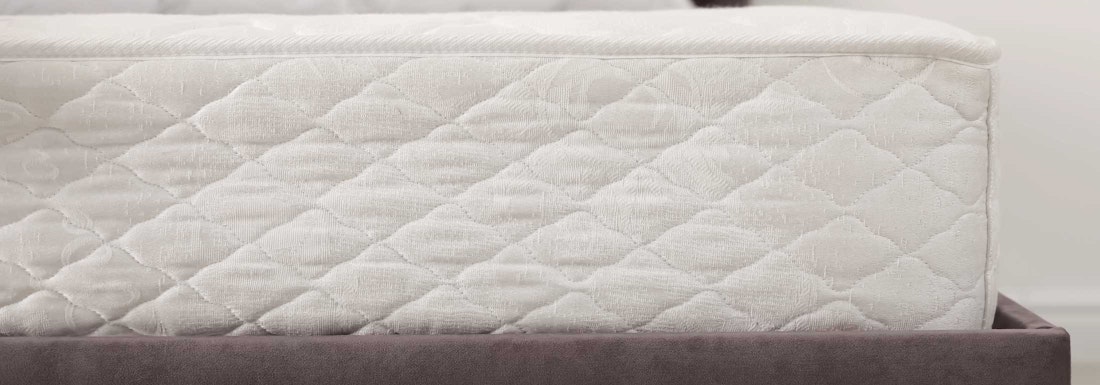13 Oct 2025

How To Get Rid of Mould on Your Mattress
21 Jul 2024
Discovering mould on your mattress can be alarming and problematic, as it poses various health risks and can compromise your comfort and sleep quality. Mould thrives in damp and poorly ventilated environments, and a mattress offers an inviting habitat due to the warmth and humidity from our bodies. If you find your sleeping sanctuary affected by mould, it's crucial to address it promptly to prevent health issues such as allergies and respiratory problems, as well as to preserve the longevity of your mattress.
Identifying Mould on Your Mattress
Discovering mould on your mattress can be both distressing and harmful to your health. Recognising mould growth early is essential in preventing its spread and ensuring a clean sleeping environment.
Visual Inspection: Mould typically appears as irregular spots or patches. Colours may vary, ranging from white and grey to green, black, or even pinkish hues. These splotches often signify a deeper issue within your mattress.
Odour Detection: Mould has a distinct, musty smell—a clear indicator even when it's not immediately visible to the eye. Trust your nose; if something smells off, a closer inspection for mould is warranted.
Allergic Reactions: Be attentive to physical responses. If you're experiencing symptoms such as sneezing, coughing, or itchy eyes predominantly while in bed, this could point towards a mould presence.
Humidity Check: Mould thrives in humid conditions. If your mattress feels damp or your bedroom has high humidity levels, there's a higher chance of mould development.
|
Visual Signs |
Smell |
Symptoms |
Environmental Clues |
|
Spots or patches |
Musty odour |
Allergic reactions |
Dampness |
It's crucial to address any signs of mould promptly, as prolonged exposure can exacerbate health issues and lead to a more extensive infestation.
Preventative Measures to Discourage Mould
Ensuring your mattress remains mould-free involves creating an environment where mould struggles to grow and maintaining cleanliness rigorously.
Maintaining the Right Environment
- Humidity Control: Strive to keep your bedroom’s humidity level between 30% and 50%. Use a dehumidifier or moisture absorbers to regulate the humidity, especially during damp weather conditions.
- Ventilation: Ensure good air circulation by opening windows or using a fan. This helps to reduce moisture accumulation, which mould thrives on.
- Avoid Dampness: Never go to bed with wet hair or damp clothing, and avoid placing your mattress on the floor or against cold walls, which can create condensation and promote mould growth.
- Using a mattress protector will prolong the life of your mattress.
Regular Cleaning Routines
- Weekly Linen Changes: Change and wash your bedding at least once a week using hot water, as it helps kill mould spores that may have gathered.
- Monthly Mattress Maintenance: Vacuum your mattress monthly to remove dust and potential mould spores. Ensure the mattress is completely dry before re-covering with fresh bedding.
- Immediate Stain Response: Treat any spills or moisture immediately with a dry cloth and a mild detergent. Make sure the mattress is fully dry before re-making the bed.
Effective Mold Removal Techniques
To effectively rid your mattress of mold, you can employ either natural remedies or chemical solutions, depending on your preference and the supplies you have available.
Natural Remedies
Baking Soda: A natural deodoriser, baking soda helps to absorb moisture and creates an environment hostile to mold growth.
- Liberally sprinkle baking soda over the entire surface of your mattress.
- Leave it for several hours to absorb the mold spores.
- Vacuum off the baking soda thoroughly.
Tea Tree Oil and Vodka: A mixture of tea tree oil and vodka serves as an antimicrobial spray that can tackle mattress mould.
- Mix 1 teaspoon of tea tree oil with 1 cup of vodka in a spray bottle.
- Spray the solution across the entire mattress.
- Allow it to dry completely.
Chemical Solutions
Soap and Warm Water: A simple yet effective method to cleanse your mattress of mold.
- Prepare a solution of warm water and mild detergent.
- Scrub the mattress with the solution using a sponge or cloth.
- Rinse with a damp cloth and let the mattress air dry completely.
Lysol: This commercial disinfectant can eradicate mold spores and is convenient for quick treatments.
- Spray Lysol evenly over the surface of the mattress.
- Allow it to air dry.
- Ensure good ventilation during and after application to dissipate the strong disinfectant odour.
Frequently Asked Questions
What are the health risks associated with mold presence on a mattress?
Exposure to mould on your mattress can lead to health issues such as respiratory problems, allergic reactions, and skin irritation. The severity of these health risks often depends on your sensitivity to mould and the duration of exposure.
What leads to the development of mold on mattresses?
Mold on mattresses typically develops due to excess moisture, which can arise from high humidity, spills that aren't properly dried, or sweat. Inadequate ventilation beneath the mattress can also contribute to this problem.
How can one effectively eliminate mold from a mattress using household cleaning agents?
To remove mould, you can create a solution of equal parts rubbing alcohol and warm water or utilise a tea tree oil and vodka mixture. Apply the solution to the affected areas and scrub thoroughly to eliminate the mould. Always ensure the mattress is completely dry afterwards.
What are the early signs of mold growth in mattresses?
Early indicators of mould growth include a musty odour, visible spots or patches in various colours such as black, green, or white, and potential worsening of allergy symptoms when you are near the mattress.
Is it possible to salvage a mattress that has been contaminated with mold?
You may salvage a mattress with mould contamination by thoroughly cleaning and disinfecting it. However, if the mould has penetrated deeply into the mattress, it might be safer to replace it to avoid health risks.


